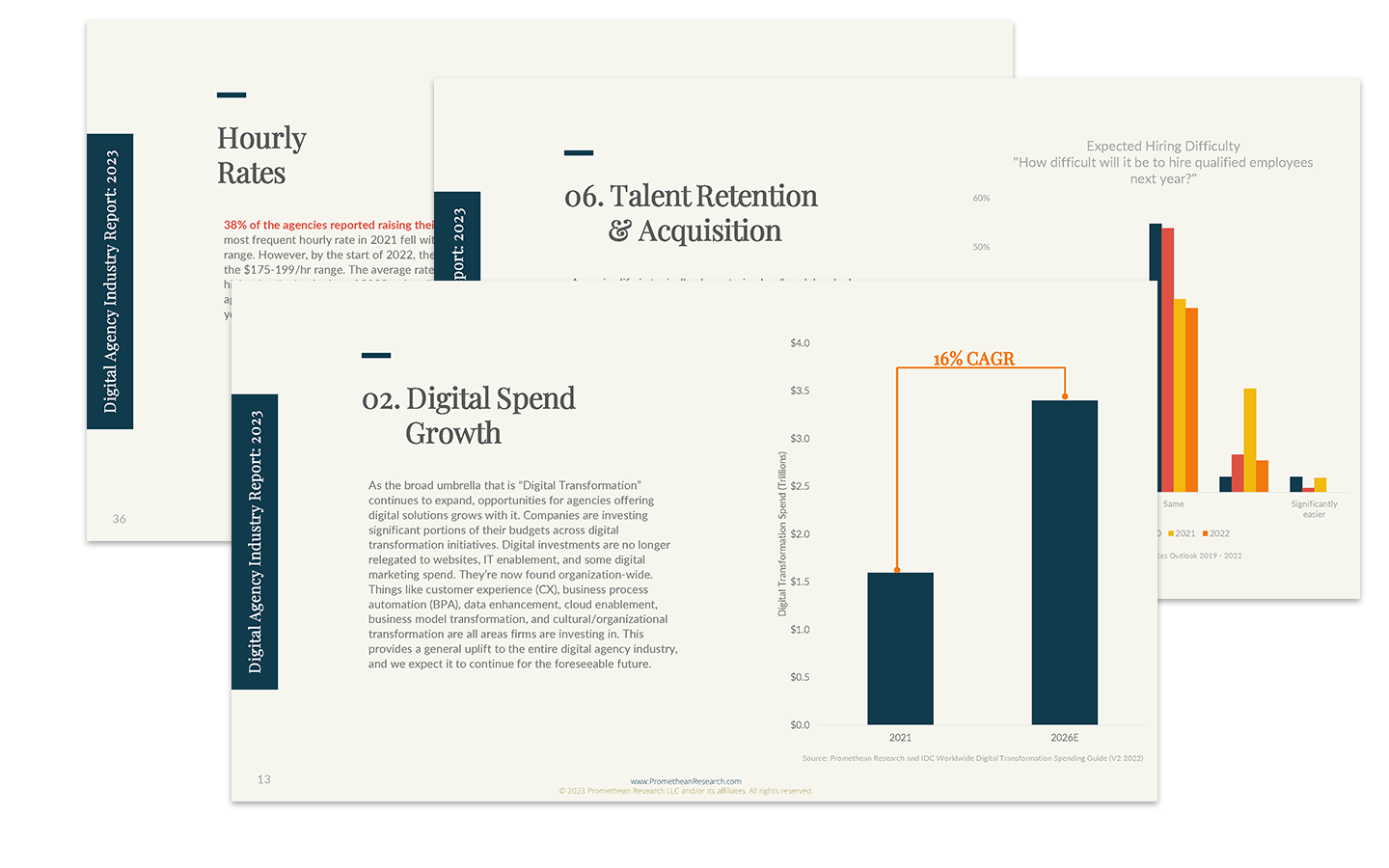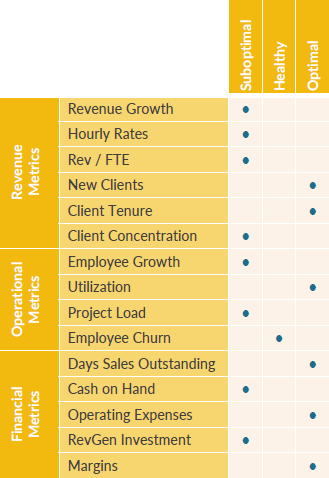Digital Agency Industry Report
Digital agencies are able to generate an above-average level of net income, they have few, if any, barriers to entry, and the market as a whole is growing at a rapid pace. This makes digital agencies an attractive industry for many participants.

An attractive industry
Despite its attractiveness, many of the industry’s best practices are underdeveloped or poorly disseminated. Over the last five years, the average level of sophistication has been increasing, and owners are paying closer attention to how and where their firms operate.
This report offers an in-depth analysis of this dynamic sector, identifying key trends, drivers, and standard structures of digital agencies. Our research encompasses over 45,000 digital agencies across more than 20 countries since 2015, utilizing online surveys, interviews, and secondary research sources. The insights we present are based on this proprietary data collected by Promethean Research and other secondary sources.
This research, combined with additional data we’ve gathered, enables us to guide our digital agency clients more effectively. We strive to uncover opportunities, refine strategies, and design new pathways to success in an ever-changing environment. Join us as we delve into the heart of this rapidly evolving industry.
Top 10 key themes & drivers
Digital agencies are driven by the needs of their clients. At large organizations, digital strategy will be directed by C-level executives and/or Vice Presidents of various functional groups. At smaller firms, owners, CEOs, or presidents will direct the strategy, with VPs and/or directors influencing them. These needs have evolved as various industries become more competitive, especially as digital capabilities have moved to the top of priority lists.
Below we explore the top 10 key themes and drivers that are shaping the digital agency industry.
01. A growing market
The number of digital agencies in the U.S. has grown 54% from 2018 to 2023. The average size of an agency has also increased. We’re seeing a shift from 73% of the market in the 0-10 FTE range in 2018 to 64% in 2023. Most of them have grown to the 11-50 FTE cohort that now makes up 27% of the market, up from 21% in 2018.
02. Digital spend growth
As the broad umbrella that is “Digital Transformation” continues to expand, opportunities for agencies offering digital solutions grows with it. Companies are investing significant portions of their budgets across digital transformation initiatives. Digital investments are no longer relegated to websites, IT enablement, and some digital marketing spend. They’re now found organization-wide. Things like customer experience (CX), business process automation (BPA), data enhancement, cloud enablement, business model transformation, and cultural/organizational transformation are all areas firms are investing in. This provides a general uplift to the entire digital agency industry, and we expect it to continue for the foreseeable future.
03. The advent of artificial intelligence
After OpenAI released its GPT-3 model in 2020, a flood of natural language content tools hit the market. Based on our survey data, over half of digital agencies were using some kind of AI assistance by the end of 2022. Everything from coding to content creation is being affected. It’s too soon to tell just how this will play out, but it has the trimmings of a sizable industry shift.
04. Unequal agency maturing
Fragmentation and high employee turnover in the digital agency industry lead to sizable opportunities. Best practices aren’t easily created or disseminated throughout the industry. This lack of industry cohesion allows an individual organization to significantly outperform its peers by simply implementing a few key best practices.
05. Shifting agency margins
The economics of running a digital agency have shifted over the last few years. This has been due to two significant shifts, the first being inflationary and demand pressure on service pricing, and the second being margin pressure from historically high salary shifts. The general guidelines for digital agencies used to be: 45-50% of revenue spent on cost of goods sold, 20-25% of revenue on operating expenses, and then a pre-tax net income of 25-35%.
The two shifts above have slightly offset one another, but for now, it appears that the salary pressure has had a slightly greater impact. We now see the following breakdown as standard for a digital shop:
- 55% of revenue spent on COGS
- 25-30% of revenue spent on Operating Expenses
- 17% pre-tax Net Income.
We believe the growing competition has also played a role in the downward pressure on margins. What this means is that shops are going to have to increase their level of sophistication to compete successfully. Things like time tracking, managing utilization rates, service mix optimization, and targeted industry focuses are becoming table stakes.
UPDATE: Our recent research into how artificial intelligence impacts digital agencies has shown the potential for significant margin expansion. Learn more here: Artificial Intelligence is Disrupting Digital Agencies.
06. Talent Retention & Acquisition
Agencies life is typically characterized as “work hard, play hard,” but if you ask the average employee, they’ll say it leans more towards the former than the latter. This, along with average agency salaries just above the U.S. median salaries, makes employee retention a challenge. Some shops have moved to the “churn-n-burn” approach, which has serious negative long-term consequences.
Talent acquisition is a difficult challenge, as evidenced by the consistently large number of job openings at U.S. agencies. The high industry fragmentation makes building a good reputation difficult, which in turn makes it harder to attract applicants. Once they are attracted though, work-life balance, compensation packages, promotion potential, etc., all play a part in the ability of an agency to retain a candidate. Unfortunately, at a large number of agencies, these are not robust enough and work against the firm during the hiring process.
07. Remote workforce, offshoring, and nearshoring
Digital agencies have always been at the forefront of remote work. Many have been mostly or fully remote for years before 2020. This gave many of them an advantage when the forced global remote work experiment happened that summer. For those that didn’t have those processes in place, remote work was a struggle at first. After a few years of this, most shops have their processes worked out to support a semi-asynchronous workforce.
This crash course in async work exposed many shops to new workforces they didn’t have access to before. Offshoring and nearshoring are now used by a large percentage of the industry. This is helping offset some of the salary pressure many shops have been under, but it comes with unique costs. Getting the async communication and processes right is critical to being successful here.
08. The start of the 4-day workweek
At the start of 2022, a group in the UK piloted a six-month trial of a 4-day work week. 32hrs and no loss of pay for employees. When the results arrived in early 2023 they were pretty shocking.
- Companies continuing with 4 day week: 92%
- Number of staff leaving job: -57%
- Improved physical health: 37%
- Improved mental health: 43%
- Absenteeism: decreased
- Reduced Burnout: 71%
- Reduced Stress: 39%
- Hiring: easier
While not as drastic as the remote work shift, I expect to see a gradual transition towards a 4-day work week for digital agencies over the coming years. Agencies have typically been towards the front of employee benefits, and this seems like a significant win for both employees and management. Our survey in the first quarter of 2023 shows that even forward-thinking digital agencies are still very new to the practice.
09. In-housing of marketing spend
CMOs are constantly working to strike a balance between their internal capabilities and the value they gain from agency help. Lately, brands seem to be placing a greater emphasis on building their internal talent pools, which is placing downward pressure on agency growth.
The main force opposing this in-housing is the advent of new capabilities. Brands pay for capabilities. Did a new social media company explode on the scene? If so, brands will soon hire outside help specialized in navigating that new area. The same thing can happen in AI/ML areas, or ad targeting, etc. As these capabilities become commoditized (think general social media posting), they get in-housed or outsourced to the cheapest alternative.
The rate of change of new capabilities dictates how strong this in-housing force plays against agency growth. For now, it seems like new tech is enabling new capabilities faster than companies can create capable in-house teams.
10. A shifting fragmented marketplace
There are a few forces influencing this:
First, there are very low barriers to entry to set up a digital marketing firm. The demand for specialists ensures that top-tier talent will always have the option of setting out on their own. This option, coupled with the challenging working environment at many agencies, makes “working for yourself” an attractive option to many.
Secondly, M&A activity in this industry has remained steady over the last few years. We believe that this is due in part to the third force, limited benefits to scale. M&A in this industry tends to favor strategic capability additions rather than scale benefits.
Finally, there are limited benefits to scale for the digital marketer. After an early point, cost reduction opportunities become negligible, and the perception of working with a large monolith can actually be seen as a negative by brands. Low employee tenure also plays a factor in lower retained agency knowledge. It is difficult to benefit from employee learnings when they aren’t around long enough to pass them on to others.
The significant new entrants in the space over the last 10 years have come from the large consulting players. These firms already have deep ties with the CFOs, the CTOs, and the COOs, and now they’re expanding their business into the CMO’s budgets. The consulting firms are entering the agency space primarily through strategic acquisitions of both general agencies and small specialized shops.

Are your agency’s margins too low?
Are you growing as fast as you should?
How about your rates, are you charging enough… or too much?
What about your revgen investments, are they enough to support your growth goals?
We designed a digital agency benchmarking service to answer these questions and more. Benchmark your progress and build a better agency by this time next week:
Digital agency composition
Sizes and types
The number of digital agencies in the U.S. and Canada by full-time employee cohorts
Source: Promethean Research
Note: The size of the bubble indicates the percent of the market that size cohort represents.
By our estimates, there are just over 45,000 digital agencies in the United States and Canada. The general distribution of digital shops in the United States skews heavily towards the smaller side. Companies in the 1-10 employee range make up 64% of digital agencies. Those in the 11-50 employee range make up 27%, with the remainder being shops with >50 employees. Digital marketing agencies tend to skew the smallest, followed by web dev shops and mobile devs.
Most of the large firms (>250 employees) in this industry are comprised of agency-holding companies. These are firms that own multiple smaller independent agencies that specialize across different focus areas. These allow the holding companies to work with many clients who could be competitors by distributing them across their network of agencies. This lets the holding company avoid any conflicts of interest while still providing a diverse set of creative solutions.
The small and medium-sized firms (<50 and 51-150 employee firms) are typically single agencies that can offer more services as they become larger with respect to revenue. The smaller agencies tend to be specialty shops, while the medium-sized firms tend to be more full-service. Then the larger firms return to specializing, primarily based on the industries served.
The typical agency structure
Four functional areas of an agency
Agencies have four core functional areas: Revenue generation (Revgen), Production, Support, and Leadership.
Revgen’s role is to… generate revenue. This consists of marketing, sales, business development, and account management.
Production’s job is to do the thing your revgen team told the client you will do. This functional area houses your developers, designers, marketers, copywriters, project managers, etc., who work on or manage client projects.
Support roles act as the facilitation layer for the business. They include accounting, human resources, legal, and managers.
Finally, Leadership’s job is to set the mission, vision, and goals for the firm.
Agency functions and growth
When shops are small (<10 FTE), they usually rely on the owners to fill most of the functional roles. Owners will handle all of the revgen duties, a significant portion of the production duties, along with their leadership duties. They’ll outsource most of the support roles until they get bigger.
As they grow, shops bring in dedicated talent to fill out functional roles that were either done by the owners before, outsourced, or neglected.
Here’s a look at the relationship between the size of a firm and when they’ll bring on a dedicated employee or vendor to handle various roles.
Revenue Generation
Studio
(0 – 9 FTE)
Small
(10 – 24 FTE)
Medium
(25 – 49 FTE)
Large
(>=50 FTE)
New lead generation
P
P / E
P / E
P / E
Closing qualified leads
P
P
P / E
P / E
Brand management
P
P / E
E
E
Content creation
P
P / O
O / E
O / E
Public relations
O
O
O
O / E
Advertising
P / E / O
P / E / O
E / O
E / O
Account management
P
P / E
E
E
Business development / partnerships
P
P
P / E
P / E
P = Done by a partner
E = Done by an employee
O = Outsourced
Production
Studio
(0 – 9 FTE)
Small
(10 – 24 FTE)
Medium
(25 – 49 FTE)
Large
(>=50 FTE)
Value delivery
P / E
E
E
E
Production team management
P
P / E
E
E
Project/product management
P
P / E
E
E
P = Done by a partner
E = Done by an employee
O = Outsourced
Support
Studio
(0 – 9 FTE)
Small
(10 – 24 FTE)
Medium
(25 – 49 FTE)
Large
(>=50 FTE)
Monitor, store, and analyze financial information
P
P / O
P / O / E
P / O / E
Employee attraction, onboarding, retention, and operations
P
P / O
O / E
O / E
Operational and legal policies, contracts, and agreements
O
O
O
O / E
Production team management
P
P / E
P / E
P / E
P = Done by a partner
E = Done by an employee
O = Outsourced
Leadership
Studio
(0 – 9 FTE)
Small
(10 – 24 FTE)
Medium
(25 – 49 FTE)
Large
(>=50 FTE)
Mission, vision, and goals
P
P
P
P / E
Strategy creation
P
P
P
P / E
Roadmap design and implementation
P
P
P / E
P / E
P = Done by a partner
E = Done by an employee
O = Outsourced
Agency revenue profile
Average annual revenue growth 2015 – 2021
Source: Promethean Research
From 2015 to 2020, the average growth rate of agencies in our surveys was 13%. In 2021, the average growth rate almost doubled to 25% on the enormous demand for digital solutions by corporations. During 2022, we saw revenue growth slow back down to 15% which is much more in-line with historical trends.
As far as how an agency’s size correlates with growth rates, we see fairly similar rates between Studio (<10 FTE), Small (10-24 FTE), and Medium (25-49 FTE) sized shops. They all tend to grow around 15% a year. This changes when we look at Large (>=50 FTE) shops. They tend to grow 36% faster than the smaller shops.
RevGen structure & investment
In a standard shop of 25 employees, the responsibility of revenue generation typically falls on a partner, the CEO, or sometimes 1-2 salespeople (a Sales Development Representative – SDR, and a closer). There is typically a marketing professional that manages design and content direct reports, but there is rarely a formalized lead generation process. Sales processes are also typically bare bones. Our experience has shown that account management can fall under sales, but it usually lives under operations. Business development is typically under the CEO’s responsibilities, but we have seen cases where there are dedicated business development professionals that report directly to the CEO.
Most digital agencies will spend about 7% of their revenue on revgen activities. Those interested in growing faster than average will allocate 10-15% to revgen.
Primary lead sources
In a typical digital shop, whether it’s dev, marketing, or design, they will derive most of their leads and revenue from referrals. While referrals can be a great way to start out, relying on them for the majority of a firm’s revenue generation presents a few challenges. The first is their lack of predictability. Second, they typically come from people with similar networks, which limits the ability to grow project scopes with new referrals. Finally, there’s little to no control over the quality of the referral, and this can jeopardize relationships.
By no means are referrals bad. They’re an excellent way to grow a business, but what separates companies that can break through the 30-50 employee plateau is often a strong revenue generation engine.
Hourly billing rates and pricing methods
Average hourly rate bands for digital agencies 2021 & 2022
Source: Promethean Research
38% of the agencies reported raising their prices in 2022. The most frequent hourly rate in 2021 fell within the $150-174/hr range. However, by the start of 2022, the rate had shifted to the $175-199/hr range. The average rates climbed even higher by the beginning of 2023, primarily driven by Studio agencies catching up a bit, half of which raised their prices last year, compared to only 28% in 2021.
In 2022, seventy-five percent of firms used Time & Materials and Retainer models, while 65% used Fixed Bid pricing, and only 37% used Value-based pricing.
Fixed fee
After a blended approach, the most common way to price services is with a fixed fee structure. This model is employed by estimating the cost of a project and then adding a margin to arrive at a fixed fee the client will pay. This type of model includes retainer-based billing along with progress-based billing.
This model works best with clients who have a set budget they’re unable to exceed and need to know project costs beforehand. Both parties assume risk with these types of arrangements, as both cost overruns and savings are absorbed by the agencies. Fixed-fee models also may limit agency revenue growth as the option to add additional services typically isn’t available until the contract renewal time.
Value-based
Pricing services based on the value an agency’s work generates for a client appears to be the goal for most agencies as it aligns the agency’s and client’s goals more than the fixed-fee model and can generate substantial profits for the agency. Agencies typically experience pushback when selling this model, as value-based prices can be much higher than cost-plus pricing. This model is best employed by experienced, proven agencies that can point to successes to help clients understand the return on investment.
We have found that Value Based Pricing appears to be correlated with faster-than-average growth when the market is growing and underperforms during times of turbulence. Shops employing T&M and Retainer pricing tend to have more stable growth rates.
Hourly Rate
This is the simplest pricing model and is often employed by firms in their early stages. Here agencies price their services based on the costs and time required to perform those services and then bill on a periodic basis based on the time incurred. There can be a blended “firm-wide” hourly rate charged or different rates based on the skill level of the individuals working on the project.
The hourly rate model has the potential to incentivize inefficient practices and can misalign the agency’s incentives from the client’s. Even if an agency uses another pricing method on the surface, many resort to an hourly calculation to ensure profitability.
Performance-based
This is where agencies (typically marketing agencies vs. dev or design) will charge a fee based on the change in a particular performance metric that they influence. This metric is often sales, but it could also be something more targeted that the client’s measuring, like page views, social engagement, leads generated, etc.
Revenue per employee
Revenue per full-time employee 2015 – 2021
Source: Promethean Research
Revenue per employee, a common efficiency metric for digital agencies, has been trending upward since we began tracking it back in 2015. The average agency made $163k per full-time employee in 2022. We believe the increases in demand and pricing power are causing a general uplift in this metric vs. any kind of significant efficiency gains, but this may change as AI tools become better integrated and enable productivity gains.
Positioning and service mix
Service mix frequency
Source: Promethean Research
Roughly half of the shops in our surveys self-identify as specialists. They specialize by industry vertical, service mix, or both, but it’s much more common to see agencies focus on a certain industry niche vs. a specific service mix. As agencies get larger, they tend to specialize more. The average agency will offer between 5 and 6 distinct services.
Digital agency profitability
Average digital agency net margin 2015 – 2021
Source: Promethean Research
Agency margins are mainly influenced by two levers. The most impactful is often the billing rate. Closely behind billing rates is an agency’s utilization rate. These two levers have the most significant impact on an agency’s profitability.
The average profit margin for a digital agency in the U.S. since 2015 is 16%. Studio (<10 FTE) sized agencies are typically the most profitable, but after a shop grows past 10 FTEs, net income margins remain fairly stable at around 15%. This places digital agencies as one of the more profitable types of businesses.
The most significant expense for an agency is employee costs. Salaries and benefits make up almost all Costs of Goods Sold and a significant portion of Operating Expenses.
After employee costs, app and tool costs make up the next largest segment. According to our 2023 Digital Shop Tools Survey, the average agency spends 3.7% of its revenue (minus any passthrough spend) on tool costs.
Compensation and salaries
Salary growth by functional group
Source: Promethean Research
Salaries are by far the largest component of running a digital shop. Identifying correct market rates is made more complicated by many factors, the most critical of which is a severe lack of transparency. Between 2019 and 2022, salaries for most positions rose 25-35%.
Non-Salary compensation has grown even faster than salaries since mid-2019 as digital shops use them to both attract and retain talent in this challenging labor market. This includes things like bonuses, options, and profit-sharing.
The average employee is expected to bill 25hrs per week and work another 13hrs on non-billable tasks for a total expected weekly commitment of 38hrs.
This distribution of billable to non-billable hours is highly dependent on the position type. Internally-focused marketers and Business Development / Sales employees are expected to bill the fewest hours weekly, with many not being required to bill any. Production employees (Designers, Developers, and client-focused marketers) are expected to bill the most, around 30hrs/week.
The average combined compensation for an owner in our 2022 Salary Survey was $242k, half of which was salary, while the other half was comprised of dividends, withdrawals, bonuses, or other cash compensation.
Firm size correlated with greater compensation. Studio shop owners took home an average of $171k, Small shop owners earned $252k, and Medium shop owners received an average of $351k.Salaries
Owners of any company size received average combined benefits of around $20k.

More articles
Digital Agency Salary Survey
A study examining how digital agency employees and leaders are compensated.
Artificial Intelligence is Disrupting Digital Agencies
Early indications show AI has a 15-25% productivity boost for production-level employees. If this holds true for agency-wide gains, it could result in an 81% increase in net income for those shops that successfully implement it.
Trust Your Experts
Remove a major growing pain by building trust and realizing that not all opinions are equal.
Our latest insights on running digital agencies
Exclusive research opportunities, thoughts, and advice on the digital agency industry every two weeks.

"Best / most valuable updates from anyone in ages. I get hit up soooooo much, keep this kind of newsletter / value up."
Wil Reynolds
CEO, Seer Interactive



